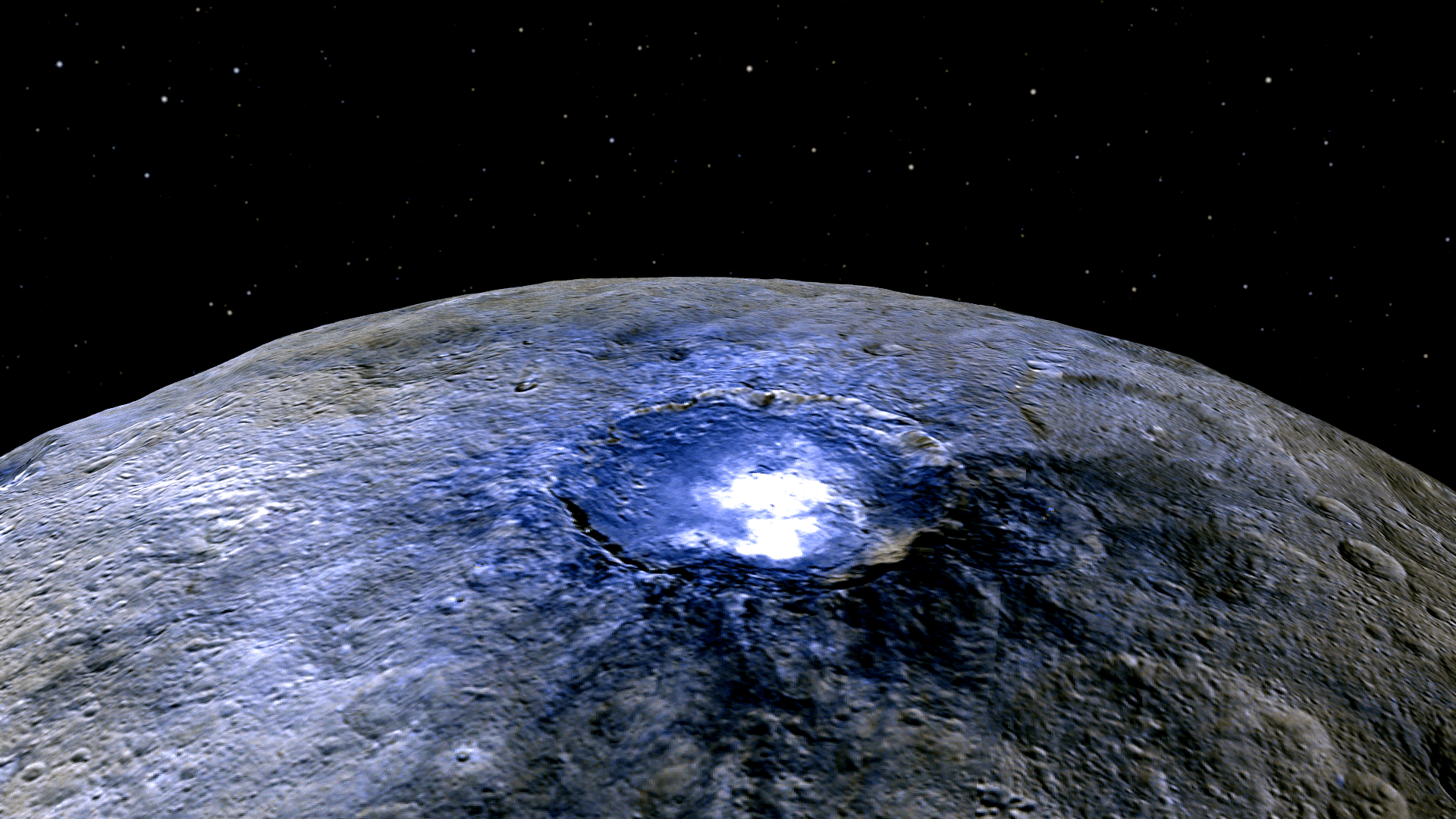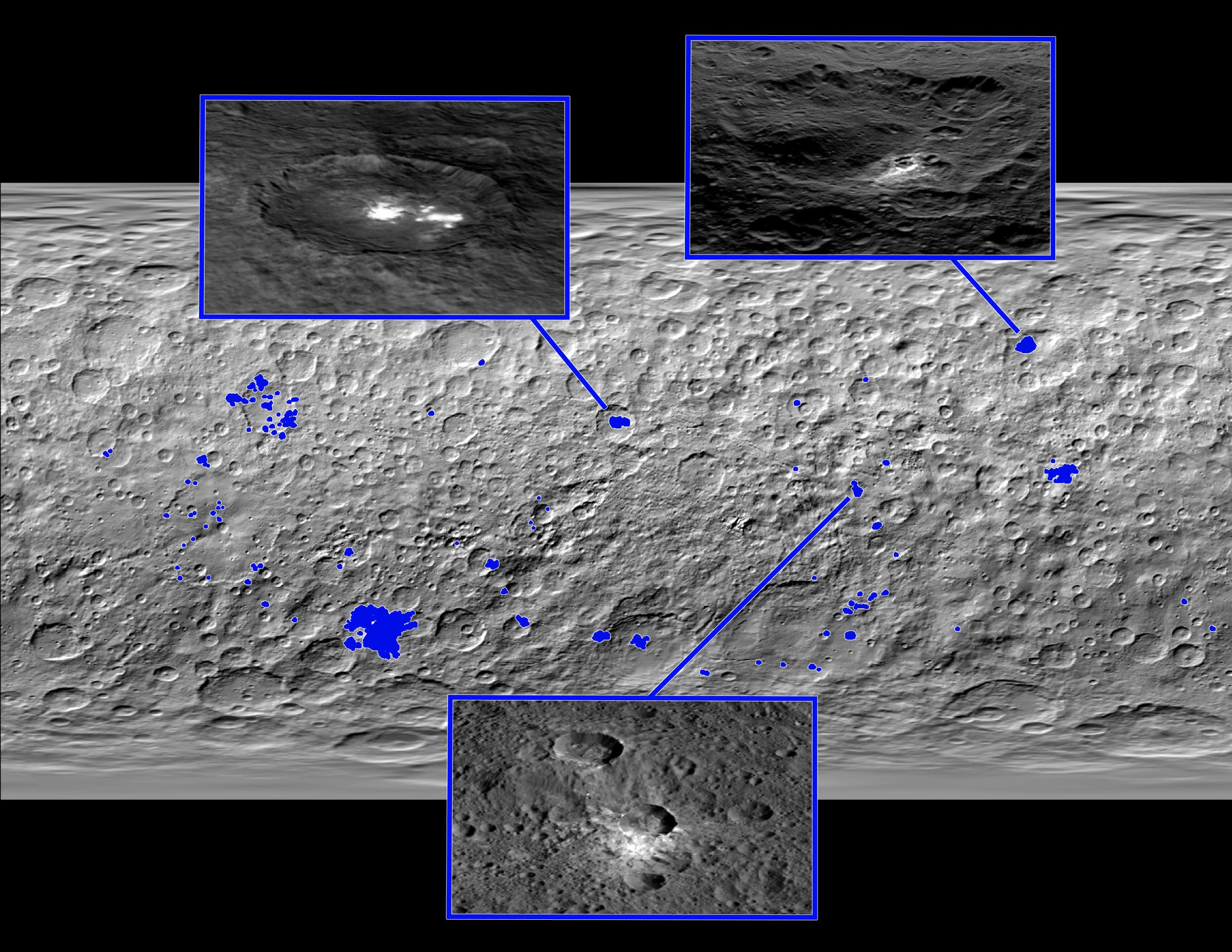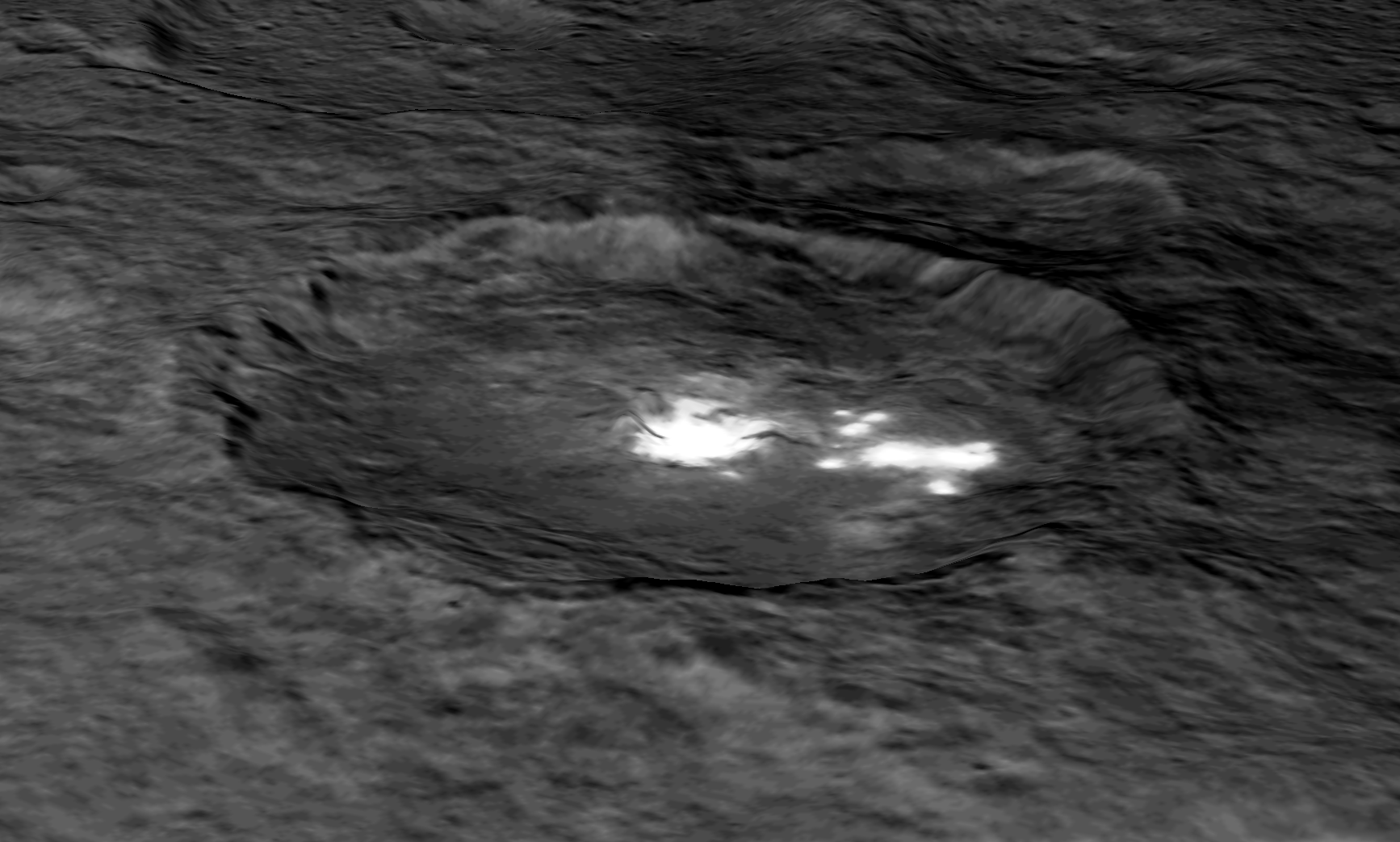
With NASA’s Dawn spacecraft set to enter its final and lowest orbit around the dwarf planet Ceres, spectral measurements are enabling researchers to gradually unravel the nature of the numerous mysterious and intriguing bright spots recently discovered, and now they conclude that briny mixtures of ice and salts apparently reside just beneath certain patches of the pockmarked surface and that “water is sublimating” from the surface of an “active crater”.
Indeed, excited scientists report that high resolution images and spectra from Dawn indicate that Ceres is an active world even today, according to a pair of newly published scientific papers in the journal Nature.
Ceres occupies a very ”unique niche” unlike any other world in our Solar System with “occasional water leakage on to the surface,” Dawn Principal Investigator Chris Russell told Universe Today.
Orbital measurements from the probes Framing camera reveal that the bright areas likely contain hydrated magnesium sulphates, a class of mineral salts found inside the brightest spot on Ceres, namely Occator crater – which are the salt-rich leftover residues from water evaporation.
The newly released results also show evidence of a diffuse haze of water vapor above Occator crater, which appears to be among the youngest features on Ceres, as well as at a second region at Oxo crater.
The Cerean haze is formed by the warming effects of sunlight shining on the hydrated salts inside the crater. The salts were exposed by past impacts of asteroids all across Ceres. The haze could be comprised of “condensed-ice or dust particles.”
“The Occator crater on the surface of dwarf planet Ceres is active: data from NASA’s Dawn mission indicate water sublimating from its center,” say Dawn researchers in a statement.
Video caption: Ceres Rotation and Occator Crater. Dwarf planet Ceres is shown in these false-color renderings, which highlight differences in surface materials. Images from NASA’s Dawn spacecraft were used to create a movie of Ceres rotating, followed by a flyover view of Occator Crater, home of Ceres’ brightest area. Credits: NASA/JPL-Caltech/UCLA/MPS/DLR/IDA
“Of particular interest is a bright pit on the floor of crater Occator that exhibits probable sublimation of water ice, producing haze clouds inside the crater that appear and disappear with a diurnal rhythm. Slow-moving condensed-ice or dust particles may explain this haze,” write the authors in the Nature paper.
Occator is the brightest of more than 130 strikingly bright patches spread across the Texas-sized world, which ranks as the largest object in the main asteroid belt between Mars and Jupiter. It has an average diameter of 584 miles (940 kilometers).

NASA says Occator is a rather new impact crater, formed by an asteroid impact as recently as only 70 million years.
“The most plausible interpretation of our results is that there is a mixture of ice and salts under at least some parts of Ceres’ surface,” says lead study author Andreas Nathues of the Max Planck Institute for Solar System Research, Göttingen, Germany, in a statement.
“This material could be exposed by the impacts of medium-sized asteroids. The ice gradually evaporates until only salts and phyllosilicates are left.”
The mysterious bright spots inside Occator crater – looking somewhat like a pair of alien eyes – were only discovered earlier this year as NASA’s Dawn orbiter was on its final approach to Ceres.
Occator measures about 60 miles (90 kilometers) across and 2 miles (4 kilometers) deep. It also features a central pit “covered by this bright material, that measures about 6 miles (10 kilometers) wide and 0.3 miles (0.5 kilometers) deep. Dark streaks, possibly fractures, traverse the pit. Remnants of a central peak, which was up to 0.3 miles (0.5 kilometers) high, can also be seen,” say officials.

Prior to entering orbit on March 6, 2015, scientists speculated that Ceres might harbor a subsurface ocean of liquid water that could be hospitable to life.
Now with new data in hand, the presence of a large subsurface ocean of liquid water or water ice appears ever more likely.
“The global nature of Ceres’ bright spots suggests that this world has a subsurface layer that contains briny water-ice,” noted Nathues, who is also lead investigator of the Framing camera team.
The bright spots of Occator have captivated popular imaginations worldwide even as scientists struggled mightily, until recently, to explain what they really are.
Possible explanations ranging from frozen ices, salts, geysers and cryovolcanoes have been proposed for the past year as researchers sought to gather measurements explaining their elusive cause.
“We are currently probably seeing remnants of an evaporation process exhibiting different stages in different locations. Perhaps we are witnessing the last phase of a formerly more active period”, says Nathues.
To date, there has been no unambiguous detection of water ice on the surface of Ceres.
“Occasional water leakage on to the surface could leave salt there as the water would sublime,” Prof. Chris Russell, Dawn principal investigator told Universe Today recently in an exclusive.
“The big picture that is emerging is that Ceres fills a unique niche.”
“Ceres fills a unique niche between the cold icy bodies of the outer solar system, with their rock hard icy surfaces, and the water planets Mars and Earth that can support ice and water on their surfaces,” Russell, of the University of California, Los Angeles, told me.
On Oct. 23, Dawn began a seven-week-long dive that uses ion thruster #2 to reduce the spacecrafts vantage point from 915 miles (1,470 kilometers) at the High Altitude Mapping Orbit (HAMO) down to less than 235 miles (380 kilometers) above Ceres at the Low Altitude Mapping Orbit (LAMO).
Dawn is slated to arrive at LAMO by mid-December, just in time to begin delivering long awaited Christmas treats.
Dawn is Earth’s first probe in human history to explore any dwarf planet, the first to explore Ceres up close and the first to orbit two celestial bodies.
The asteroid Vesta was Dawn’s first orbital target where it conducted extensive observations of the bizarre world for over a year in 2011 and 2012.
The mission is expected to last until at least March 2016, and possibly longer, depending upon fuel reserves.
“It will end some time between March and December,” Dr. Marc Rayman, Dawn’s chief engineer and mission director based at NASA’s Jet Propulsion Laboratory, Pasadena, California, told Universe Today.
Stay tuned here for Ken’s continuing Earth and planetary science and human spaceflight news.
